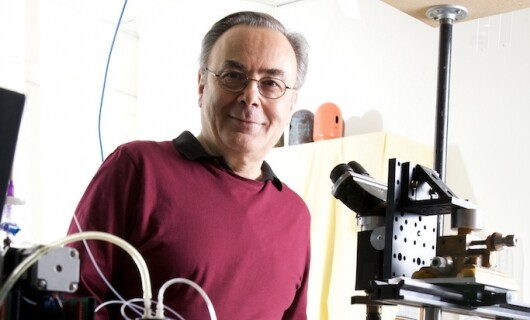What do St. Paul’s Cathedral and Itzhak Perlman have to do with faster diagnosis of diseases? Quite a lot, actually. Researchers led by Professor Stephen Arnold at Polytechnic Institute of New York University have developed an ultra-sensitive biosensor that is designed to inexpensively identify viruses in a doctor’s office in a matter of minutes instead of the weeks needed by conventional techniques. The biosensor can detect the even the smallest RNA virus particle, MS2, which weighs only six attograms (10-18 grams).
The Whispering Gallery-Mode Biosensor, to give it its proper name, derives its name from the famous Whispering Gallery under the dome of London’s St. Paul’s Cathedral. There a visitor can whisper next to the circular gallery wall and the curvature of the wall carries the sound around the gallery and the whisper can be heard clearly anywhere along the circumference. The shape of the wall holds the soundwaves next to it and bounces them around in a tight pattern.
The Whispering Gallery-Mode Biosensor works on the same principle, only using light instead of sound. The heart of the sensor is a glass microsphere. A tunable laser is led into the sphere with a fiberoptic cable and the beam shoots around the curve of the ball like sound in the Whispering Gallery until it covers every point of the sphere. If there are any viral particles in contact with the sphere, this changes its resonant properties, which affects the laser. The resulting shift in resonant frequency can then be measured. This effect is enhanced by coating the microsphere with gold nanoparticles, which can be treated to attract specific proteins or viruses.

The idea behind this came when Arnold was watching a performance of the violinist Itzhak Perlman: “I was watching Perlman play,” said Arnold. “And suddenly I wondered what would happen if a particle of dust landed on one of the strings. The frequency would change slightly, but the shift would be imperceptible. Then I wondered what if something sticky was on the string that would only respond to certain kinds of dust?”
The biosensor has been patented and is currently undergoing commercial development. As for Arnold and his team, they are tweaking the sensor to detect single proteins. If this can be achieved, Arnold believes that detecting antibody proteins that the body creates in response to viruses will allow diseases to be caught and treated much sooner.
The team's findings are described in the most recent issue of Applied Physics Letters.






